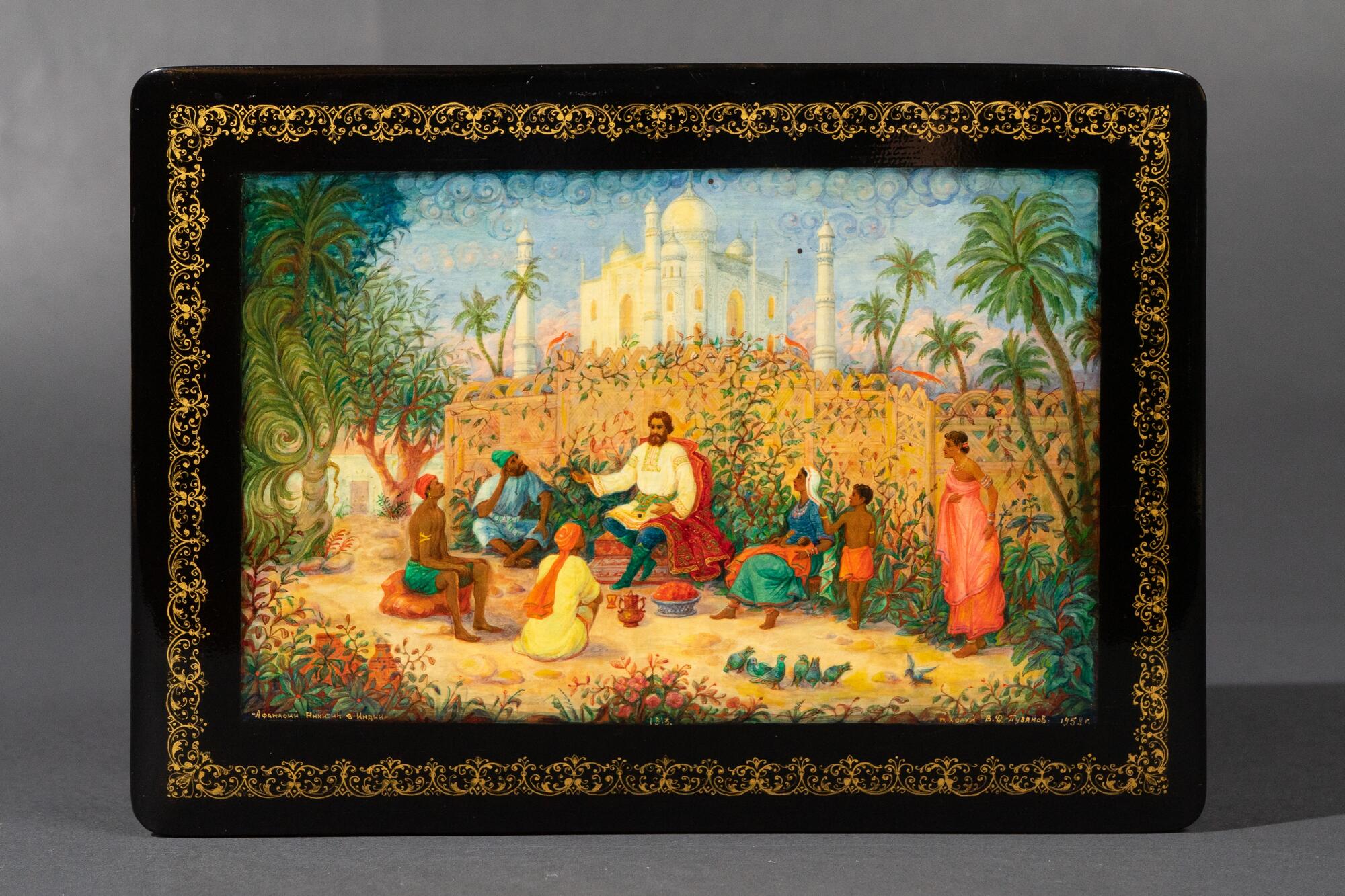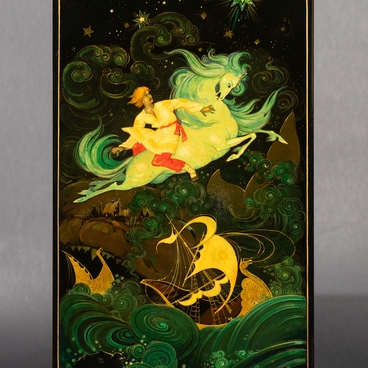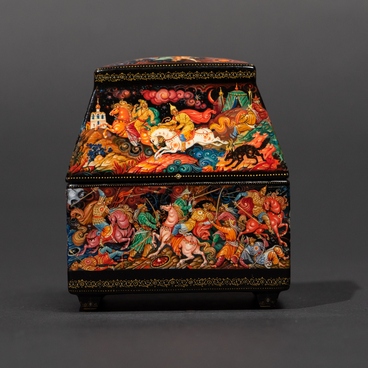Vasily Dmitrievich Puzanov-Molyov is one of the founders of Kholuy lacquer miniature. He was born in 1892 into the family of a handicraftsman-shoemaker and studied at the Kholuy School of Icon Painting. In 1909, he was recognized as one of the best students and sent to the Moscow Icon Painting Chamber, located in the Donskoy Monastery.
Pavel Korin, a native of Palekh and later a prominent Russian painter, perfected his art at the Chamber at the same time with him. In 1911, they worked together on frescoes at the Convent of Martha and Mary under the guidance of famous artist Mikhail Nesterov. Vasily Puzanov-Molyov participated in the painting of the Feodorovskaya Church in Tsarskoye Selo, painted the Moscow Epiphany Cathedral in Dorogomilovo, and the State Bank in Nizhny Novgorod.
In 1934, the artist joined the Kholuy Artel of Artists and began working in lacquer miniature painting. He developed a peculiar style of painting, which differed from that of Palekh and Mstyora. Puzanov-Molyov introduced a variety of new subjects in Kholuy miniature.
Since the 1940s, the master developed an interest in history. He created an entire series of compositions on historical, literary and fairy-tale motifs: ‘Boris Godunov and the Fool’, ‘Ivan the Terrible Meets Messengers from Yermak’, ‘The Call of Minin and Pozharsky’, ‘Afanasy Nikitin in India’, ‘Sadko’ and others.
The miniature ‘Afanasy Nikitin in India’ is based on the famous travel notes of a merchant from Tver who lived in the 15th century — ‘A Journey Beyond the Three Seas’. Afanasy Nikitin became the first European to visit India in the 15th century: he arrived there more than 25 years before the Portuguese explorer Vasco da Gama.
The work of Athanasy was the first of its kind: prior to him, it was customary for Russian authors to create travel notes only about pilgrimages to holy places. Afanasy wrote about a commercial trip. The author generously shared his observations about the cultures of different countries he visited: he wrote about the Caucasus, Persia, India and the Crimea. The three ‘seas’ mentioned in his notes are the Derbent (the Caspian Sea), the Arabian (the Indian Ocean) and the Black Sea.
Most of the notes are dedicated to India, where Afanasy Nikitin spent about four years travelling. The author was amazed by what he saw and described the way of life of Hindus in lucid colors. He wrote in detail about the rich feasts and ceremonial appearances of princes, the life of ordinary people, Indian flora and fauna. At the same time, many lyrical digressions and autobiographical episodes were included in the ‘Journey Beyond the Three Seas’.
Vasily Puzanov-Molyov was inspired by this story and created a multi-figure composition. Afanasy Nikitin is depicted in the center of the painting on a raised platform, surrounded by Hindus: women, men and children. They listen attentively to his stories, not hiding their sincere surprise.
Pavel Korin, a native of Palekh and later a prominent Russian painter, perfected his art at the Chamber at the same time with him. In 1911, they worked together on frescoes at the Convent of Martha and Mary under the guidance of famous artist Mikhail Nesterov. Vasily Puzanov-Molyov participated in the painting of the Feodorovskaya Church in Tsarskoye Selo, painted the Moscow Epiphany Cathedral in Dorogomilovo, and the State Bank in Nizhny Novgorod.
In 1934, the artist joined the Kholuy Artel of Artists and began working in lacquer miniature painting. He developed a peculiar style of painting, which differed from that of Palekh and Mstyora. Puzanov-Molyov introduced a variety of new subjects in Kholuy miniature.
Since the 1940s, the master developed an interest in history. He created an entire series of compositions on historical, literary and fairy-tale motifs: ‘Boris Godunov and the Fool’, ‘Ivan the Terrible Meets Messengers from Yermak’, ‘The Call of Minin and Pozharsky’, ‘Afanasy Nikitin in India’, ‘Sadko’ and others.
The miniature ‘Afanasy Nikitin in India’ is based on the famous travel notes of a merchant from Tver who lived in the 15th century — ‘A Journey Beyond the Three Seas’. Afanasy Nikitin became the first European to visit India in the 15th century: he arrived there more than 25 years before the Portuguese explorer Vasco da Gama.
The work of Athanasy was the first of its kind: prior to him, it was customary for Russian authors to create travel notes only about pilgrimages to holy places. Afanasy wrote about a commercial trip. The author generously shared his observations about the cultures of different countries he visited: he wrote about the Caucasus, Persia, India and the Crimea. The three ‘seas’ mentioned in his notes are the Derbent (the Caspian Sea), the Arabian (the Indian Ocean) and the Black Sea.
Most of the notes are dedicated to India, where Afanasy Nikitin spent about four years travelling. The author was amazed by what he saw and described the way of life of Hindus in lucid colors. He wrote in detail about the rich feasts and ceremonial appearances of princes, the life of ordinary people, Indian flora and fauna. At the same time, many lyrical digressions and autobiographical episodes were included in the ‘Journey Beyond the Three Seas’.
Vasily Puzanov-Molyov was inspired by this story and created a multi-figure composition. Afanasy Nikitin is depicted in the center of the painting on a raised platform, surrounded by Hindus: women, men and children. They listen attentively to his stories, not hiding their sincere surprise.



